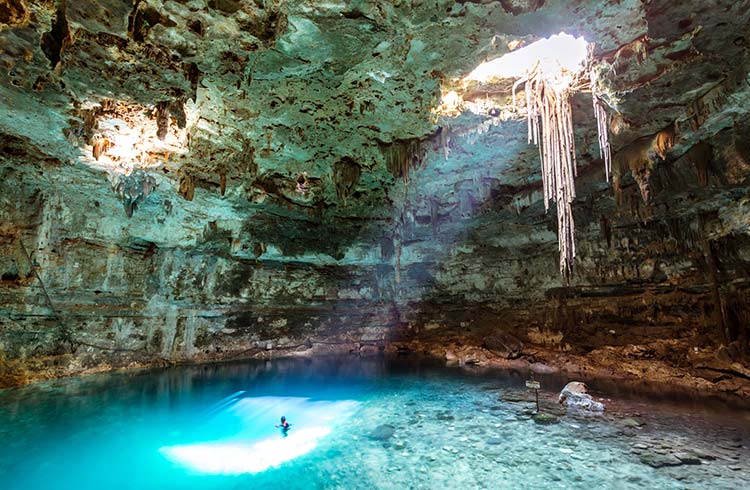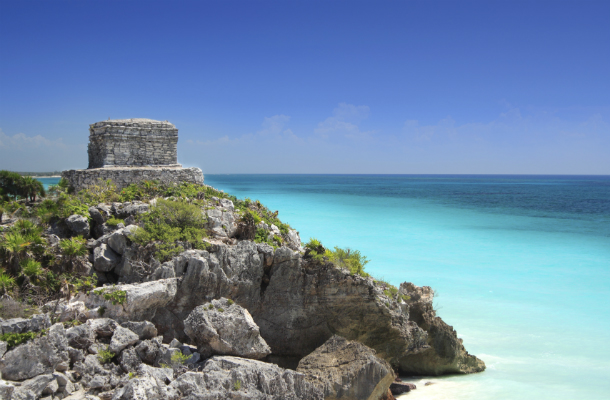Beyond Cancun: Yucatan Off the Beaten Path
If tourist resorts and crowded beaches aren't your thing, ditch Cancun and Playa del Carmen for these alternative destinations on Mexico's Yucatan Peninsula.
 Photo © Getty Images/Matteo Colombo
Photo © Getty Images/Matteo Colombo
Cancun is one of Mexico's most popular destinations, but if you're interested in more than flopping on a beach or hanging out at an expensive resort, take some time to see less touristy parts of the Yucatan Peninsula.
Once you go off the beaten path, there's plenty for adventurous souls to see and do, with thousands of cenotes (natural swimming holes), and the densest concentration of Mayan ruins in all of Mexico.
The best way to explore the Yucatan Peninsula is by car. You can rent one in Cancun for around $720 pesos (
Tulum
The major draw to Tulum are the Mayan ruins on the beach. There are also some beautiful and accessible cenotes in the area, some of the best on the Peninsula.
About two hours south of Cancun, Tulum is the antithesis of it. Most of the accommodation at Tulum Playa is eco-friendly – many switch off the power at midnight, and facilities are designed to protect and be in harmony with the environment (you cannot flush toilet paper here). You'll need to go into Tulum Pueblo to stock up on supplies.
It’s a generally cheaper base than Cancun or Playa del Carmen for exploring the ruins and cenotes of the Yucatan. To get the most out of your visit to the Tulum ruins (north of the playa), go early in the morning or late in the afternoon to miss the day-trippers.

Mahahual
On the southern end of the coast is a town that was once a sleepy fishing port. In the northern end of Mahahual, a cruise ship jetty dramatically changed the town, which now caters to tourists with restaurants, bars, quad bikes, and jet skis. Venture further south for a more authentic experience, where the cruise ship crowds haven't influenced the local scene.
Sian Ka´an Biosphere
South of Tulum, this well-preserved natural reserve offers camping, pristine beaches, cenotes, and diverse wildlife. Here, you can see dolphins, manatees, crocodiles, turtles, take a bird-watching excursion, or go scuba diving to see diverse coral beneath the water.
Punta Allen
Travel 31mi (50km) south from Tulum to see the small fishing village of Punta Allen. Located in the Si'an Ka'an Biosphere, there are a number of walking trails and natural swimming holes to be explored. Visit the ancient ruins of Muyil, hop on board a launcha to tour the mangroves, or go snorkeling on the reef.
Bacalar Lagoon
Bacalar Lagoon is a 26mi (42km) long, narrow lake, no more than 1.2mi (2km) at its widest point. You can go diving, kayaking, swimming, and snorkeling here, or venture into the dense jungle that surrounds the lagoon to see some fascinating Mayan sites. Don't mistake the Bacalar stromatolites for boring old rocks. These are some of the oldest living fossils in the world – and you can swim past them or kayak to see them at Cenote Cocalitos.
Valladolid
Valladolid is a small, colonial city between Cancun and the state capital Merida. It’s the closest town to Chichen Itza, the most popular Mayan archaeological site (about 28mi/45km away), and a great place to base yourself to explore other historic sites.
On the famous Calzada de los Frailes (Friars’ Road) you’ll find a Cocoa museum, where they’ll teach you the process of making traditional Mayan chocolate. Try a free sample at the end of the tour. On that same street you’ll find the Los Tres Toños tequila house, where you can learn about the tequila-making process, and be invited to a free tequila tasting.
Just a few miles from Valladolid is Ek-Balam. While there are countless archaeological sites in the Yucatan, Ek-Balam is one of the most beautiful, and far less well known than Chichen Itza.
A mile (1.5km) away from Ek-Balam, check out the X'canché cenote. Here, you can swim inside the cenote, or zip or rappel down the walls of the well.

Rio Lagartos
The small town of Rio Lagartos is well worth including on your journey through the Yucatan Peninsula. The main attraction here is the Rio Lagartos Biosphere, where keen bird watchers will enjoy the variety of species flying about. Rio Lagartos is also famous for being a primary nesting ground for flamingos in Mexico.
In the early evening, as fishermen begin to bring their boats back to shore, try asking a fisherman if they'll take you around the lake at sunset. Usually, they'll ask how much you're willing to pay, but these guys always know where the best places are to see local wildlife.
If you take a river tour, go as early in the morning as you can, as this is the best time to see crocodiles in the wild (from the safety of a boat, of course).
Don't leave without visiting the Las Coloradas Salt Mines, a 25-minute drive from Rio Lagartos. The pink waters and tall mountains of salt are an incredible sight to see.
Xcalak
Located at the southern tip of the Yucatan Peninsula, on the border with Belize, Xcalak is for those who want to really disconnect. Activities at this tiny, off-the-grid fishing village include world-class diving, snorkeling, paddle boarding/kayaking, and sport fishing.
Related articles
Simple and flexible travel insurance
You can buy at home or while traveling, and claim online from anywhere in the world. With 150+ adventure activities covered and 24/7 emergency assistance.
Get a quote


No Comments